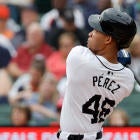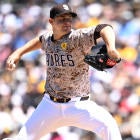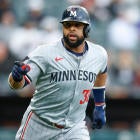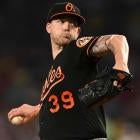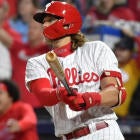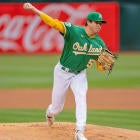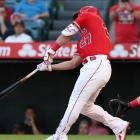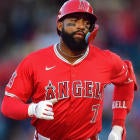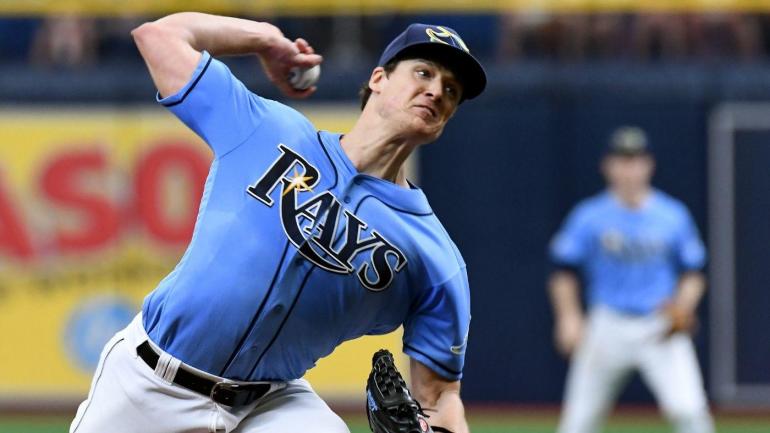
We spend a lot of our time preparing for drafts in Fantasy sports talking about players, and for good reason: You need the right players to win, after all. But here's a bit of a dirty secret: Even the best Fantasy players and analysts will miss on a significant amount of their picks. Over the last four years, first- and second-round picks hit around 70% of the time for hitters and 55-60% of the time for pitchers, and the rate for both only continues to drop, to the point where by the fourth round, you're basically at a coin flip's chance of getting a top-100 finish from a given pick.
Those numbers might sound surprising, but take a look at last year's picks with an average draft position between 36 and 48:
ADP | 2020 Finish | |
36.29 | 244 | |
36.35 | 212 | |
36.8 | 276 | |
38.1 | 29 | |
39.02 | 325 | |
40.69 | 28 | |
40.74 | 457 | |
41.51 | 190 | |
42.35 | 101 | |
42.65 | 159 | |
43.76 | 52 | |
43.86 | 109 | |
J.T. Realmuto | 46.21 | 61 |
46.53 | 695 | |
46.68 | 56 | |
46.91 | 222 |
Okay, but it was a short season, so of course, the results were unpredictable. And the fourth round was much better in 2019, with six of 11 players returning at least top 75 value. Of course, only five of 10 players drafted in the third round were even inside the top 150, so the point still stands -- once you get outside of the first couple of rounds, your chances of getting a good return on your investment are never more than about a coin flip.
Which is to say, drafting the "right" players is a lot harder than you think, and you're going to miss on plenty of guys. We've all got our guys -- here are mine -- but one of the biggest mistakes you can make as a Fantasy player is to fall in love with a name. You're not drafting biographical data, you're drafting expected production, and the name attached doesn't matter all that much.
Make your list of players you want to make sure you get, because that's one of the fun parts of playing Fantasy sports, but don't be beholden to it. It's better to have a general strategy about what kind of players you want to draft, when you want to take them, and how you're going to build out your team as you move through the draft. The exact players you want may not be there when you are picking, but you can still have a general sense of what kind of team you want to end up with by the end of your draft.
So, as we head into the final weekend of Fantasy Baseball draft season, I thought I would try to synthesize my thoughts about this year's player pool and how my drafts have typically proceeded into something like a grand unified theory of drafting for 2021. Your plan may be different -- I know Scott White's is a lot different than mine! -- but here's how I'm approaching drafts in the final week of draft season, with both Roto and H2H points leagues covered.

Fantasy Baseball Draft Kit
Your ultimate baseball draft guide
Dominate your Fantasy Baseball draft with our free Draft Kit, which gives you must-have positional and Top 300 rankings in a printable format. Plus track your draft with our lineup builder and salary cap tracker.
Thanks for signing up!
Keep an eye on your inbox.
Sorry!
There was an error processing your subscription.
But first, one piece of strategy I think is worth applying to every draft you ever do in every sport: If you identify one trend everyone seems to be following, you should at least consider going in the opposite direction. That's not to say you should be a knee-jerk contrarian, but you should think about bucking the trends because they can often be value found there.
There are obvious ways that can be applied to Fantasy Baseball in 2021, and I'll get to that shortly, but here's the best way I can explain the thought process behind it: If nine people in your 12-team league are trying to build their teams following one particular plan, you need to be better than nine different people just to have a chance; if you follow the path that only a few people are going with, you just have to be better than that small group. That doesn't guarantee you'll win, but you're going to have less competition for the type of players you are targeting, and your roster should stand out from the rest of the league in a way that could prove very valuable when you are looking to draft.
Roto draft strategy
When I talk about zigging when everyone else is zagging, in 2021, that means I'm not pushing starting pitchers up my draft board as much as everyone might be. Starting pitchers are being drafted earlier than ever in 2021, but there's no evidence to suggest that the Fantasy Baseball community is actually getting any better at drafting starting pitchers, and the early rounds are littered with pitchers who could prove to be potential landmines in your drafts.
That's not to say I'm going with some kind of zero-SP approach, of course. I'm happy to take Jacob deGrom, Gerrit Cole, and Shane Bieber in the first round, and there have been multiple leagues where I've had two starters in the first two rounds. But, I'm still leaning more heavily on the hitting side inside of the top 100 picks in most drafts. And the reason for that is simple: A draft is a zero-sum game, you always have to make sacrifices when building your team, and I'm not willing to make the sacrifices you need to make to invest in starting pitching early.
The sacrifice I am willing to make is at relief pitcher. I'm perfectly happy going through an entire draft without a single closer, knowing that about half of the closers on Opening Day will lose their job sooner rather than later. You have to be active on the wire, but there are always saves to be found if you are. Punting on saves -- or only taking late-round fliers -- is the sacrifice I'm willing to make.
That allows me to build what I believe are typically elite offenses, with all five categories covered, while still being able to compete at starting pitcher. My ideal team build will have a foundation of four pitchers I really like inside of my first 10 picks -- at least three of whom will be good bets for big inning totals -- and then a bunch of mid-to-late round fliers on young pitchers with big potential. However, what I think really makes my approach stand out is that I'm also looking to fill out my rotation with high-end, non-closing relievers.
And I don't mean someone like Devin Williams, Nick Anderson, or James Karinchak, all of whom could be drafted inside of the first 150 picks. I've used Alex Reyes as my shorthand for this kind of pitcher -- someone who could throw 90-100 innings with excellent ratios and tons of strikeouts -- but Tony Gonsolin and Dustin May are good examples too, especially since they very well could turn into high-end starting pitchers, too. I would also add starters with workload questions like Triston McKenzie or Trevor Rogers who are going late, or the likes of Amir Garrett and Tejay Antone, who could end up the Reds closer and fifth starter, respectively.
I think that combination of early inning anchors and elite ratio relievers and swingmen should allow me to compete at pitcher, and it should also allow me to build an offense without any weakness. That does mean being relatively aggressive about stolen bases, and I'm probably more likely to target Adalberto Mondesi and Victor Robles than most drafters as a result. They might just be steals specialists, sure, which can make team building tricky. But, if you're spending eight of your first 12 picks on hitters, you should be able to make up for that pretty easily.
There's no guarantee this approach will work, and the necessity of juggling categories makes every strategy risky. But, based on how drafts are going and what the player pool looks like, that's how I'm attacking my Roto and H2H categories leagues.
H2H points league strategies
Points leagues are a lot more straightforward because it's all about getting the most points. It doesn't matter how you get them, points are points. The only question in 2021 is how you should approach starting pitching in these leagues, because they cost even more than in Roto. Just take a look at the H2H points draft we did Tuesday night, where 14 of the top 24 picks were starters. Four teams doubled up on starters in the first two rounds, even.
And the thing is, the top starters will generally outproduce the top hitters, so there's some rationale behind that. In 2021, Shane Bieber outscored every hitter, and Yu Darvish outscored all but two. Justin Verlander and Gerrit Cole outscored every hitter in 2019, and Max Scherzer and Verlander did the same in 2018. The very highest end of starting pitchers will probably be the highest-scoring players this year.
However, that doesn't apply outside of the top couple of players every season. In 2019, 10 hitters had at least 600 Fantasy points, while only four pitchers did; 36 hitters had at least 500 points, compared to 15 pitchers. In 2018, the balance was closer overall -- 18 pitchers and 20 hitters did it, but then you had just 39 pitchers reach 400 points, compared to 71 hitters.
When you look at draft day cost, the highest-end pitchers perform very well compared to the hitters, too. Here's how often players drafted inside of the first 25 picks on average got to 500 Fantasy points in 2018 and 2019:
- Pitchers: 7/9
- Hitters: 23/38
Taking a pitcher with one of your first two picks generally works out, and the very best pitchers tend to outscore the best hitters. The case for taking one of the first five or so pitchers off the board is pretty clear. That case gets a lot harder to make after that. Even if we lower the threshold to 450 points, only 6 of 16 pitchers drafted in the third and fourth rounds got there in 2018 and 2019, compared to 14 out of 25 hitters. The rates were a bit closer in the fourth and fifth round ranges, which is interesting, but that disappears in the seventh round.
And, of course, those pitchers who used to be third and fourth-round picks are going off the board in the second and third now as pitching costs continue to get inflated, while the more predictable hitters are falling down draft boards.
You can look at this one of two ways. You could say that the low hit rate of pitchers means you have to invest more in the position to ensure you have enough to compete, especially since there are more viable hitters available later in the draft. That's a reasonable enough stance to take, especially with the shallower rosters in points leagues -- there are always good hitters available.
I tend to view things the other way, even in these leagues. Your draft picks are your most valuable resources for acquiring the pieces of your winning roster, and investing those resources in pitchers -- especially pitchers outside of the top tier at the position -- is a sure-fire way to waste a significant portion of those most valuable resources.
Part of that is about that "zig when they're zagging" mentality because you can load up on stud hitters while everyone else is reaching for non-elite starters. In that H2H mock draft I reference earlier, I ended up with Bryce Harper, Cody Bellinger, Xander Bogaerts and Ketel Marte with four of my first five picks, and while Marte was a bit of a reach because I'm such a believer in him, the other three were all pretty significant values. That's what you're passing up by taking Kenta Maeda and Tyler Glasnow in the third round.
Of course, I'm not going with a zero-SP build, there -- I took Shane Bieber No. 3 overall to give myself a solid base. But I think the optimal strategy in a points league is to avoid the rush for the inflated pitching prices and try to find values later on. Especially because streamers and two-start pitchers are a lot easier to stomach in a format where you don't have to worry about them wrecking your ratios.














